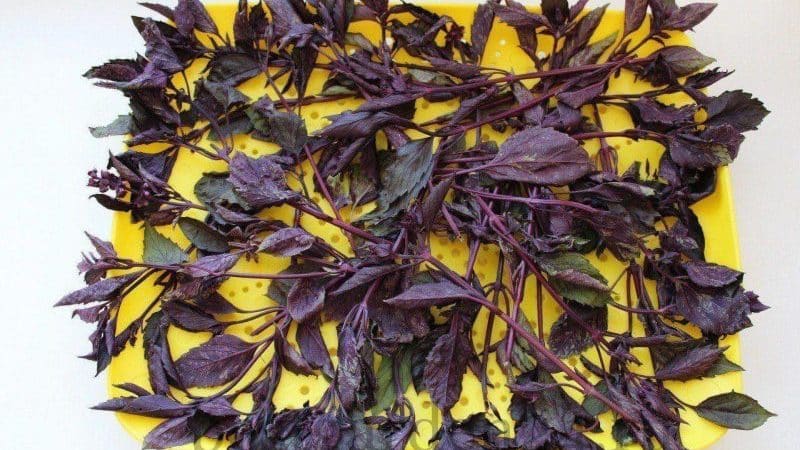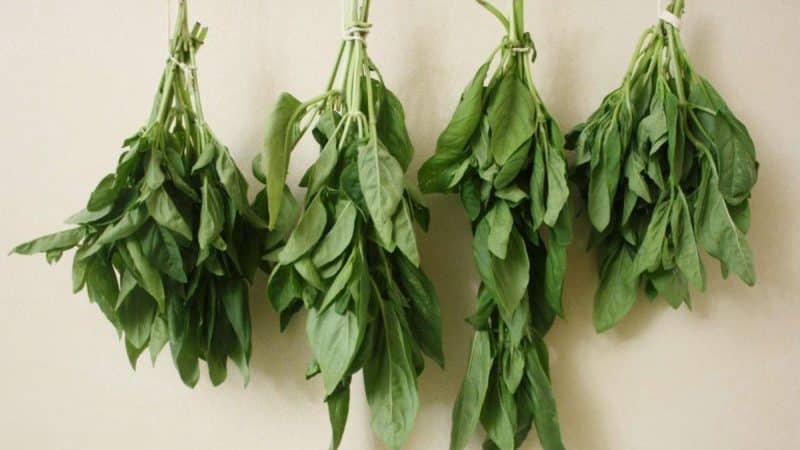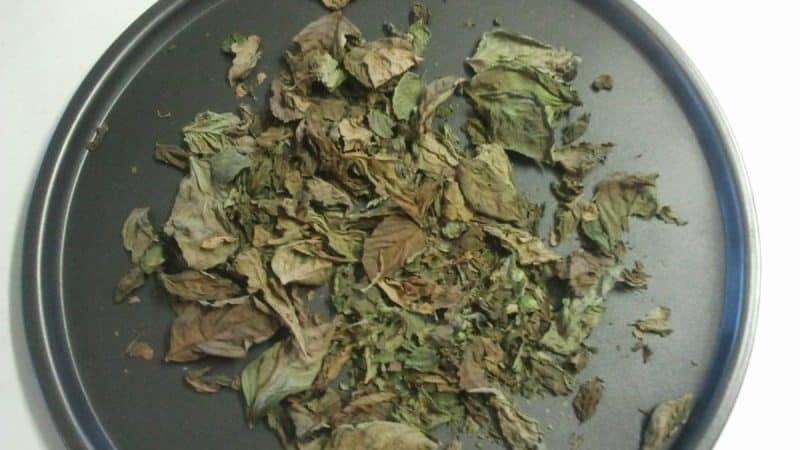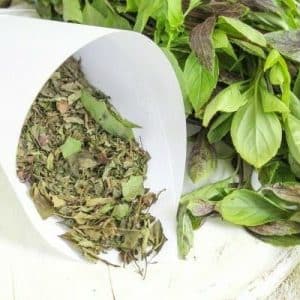When to collect and how to properly dry basil at home
Basil is an annual plant that is used in medicine, cooking and cosmetology. It is suitable as a seasoning for soups and salads, retains a pronounced aroma in frozen and dried form. Vinegar and vegetable oil are flavored with basil. We'll tell you how to dry basil at home in this article.
Is it possible to dry basil?
Using fresh herbs year-round is a difficult task; purchasing them in winter is not always possible. In this case, the solution to the problem is to prepare dried herbs at home. Basil is dried in several ways. During the process, it is taken into account that the plant should not be exposed to direct sunlight - in this case, it will lose its entire supply of vitamin C.
Important! Basil should not be consumed by people with coronary heart disease, thrombophlebitis, hypertension, or those who have had a myocardial infarction.

Advantages and disadvantages of this harvesting method
A significant advantage of this method is that a properly dried plant retains its rich chemical composition:
- vitamins A, C, K, E;
- manganese;
- iron;
- zinc;
- copper;
- phosphorus;
- selenium;
- glycosides and saponins;
- essential oils;
- tannins;
- phytoncides and sugars.
Beneficial properties of dried basil:
- replenishment of missing vitamins during diets - strict diets lead to a deficiency of nutrients, and fresh or dried basil replenishes their deficiency;
- cleansing the body - the plant helps remove toxins from the body;
- antiseptic and anti-inflammatory properties - the plant alleviates influenza, improves the functioning of the gastrointestinal tract, soothes toothache and relieves inflammation of the larynx and genital organs.
- dried herbs stimulate brain function and calm the nervous system.
The disadvantages of drying are technical in nature:
- you will need special equipment - microwave, electric dryer, etc.;
- you will have to take care of the place where it will be stored greens before drying - it should be dry, dark and well-ventilated.
Selecting and preparing basil for drying
Leaves are used as raw materials, excluding sticks, since they are rough, or flowers - it depends on the taste preferences of the cook.
The collected raw materials are sorted and washed with running water. Wet herbs are not used for drying, so the basil is shaken off and then laid out on a towel or paper in one layer. In this form, the plants are left in a dry and dark place until all the moisture has evaporated.
Important! Cannot be dried basil on the newspaper, since printing ink is poisonous and is absorbed by the plant.
When to collect it for drying for the winter
Basil is cut during the summer before or during flowering.. At this moment, the flower contains the largest amount of microelements (zinc, copper, manganese, sodium) and aromatic substances, and the stems have not yet become coarser.
The harvest is harvested twice - in July and at the end of September. It is better to pick the leaves on a dry, sunny morning - at this time they are quite dry.
Important! Air circulation, shade and warmth are the most important conditions for proper drying.
Methods for drying basil
If there are no special devices, choose one of the natural drying methods.
Bunches
For drying, young branches with 8-12 leaves are cut in bunches. The stems are washed with water, dried and tied into bundles of no more than 7 pieces. - this way the plants will dry out faster.
The finished bundles are hung on a rope at a distance of 15-20 cm from each other in a dry, dark and well-ventilated place. A barn, attic, or balcony are suitable for this purpose. After 2-3 weeks, the basil will be ready.

Sheets
For this method you will need freshly cut basil leaves. Algorithm of actions:
- Wash the leaves and dry.
- Line a baking sheet with paper (you can use window screens instead).
- Place leaves in 1 layer.
- To protect the greens from dust and insects, cover the workpiece with a nylon net or gauze. Ordinary fabric cannot be used, since its dense structure will interfere with breathability, and then the basil will be blocked and become unusable.
- Place the pan in a dark and ventilated place.
- After 2 weeks, place the dry leaves in convenient containers, tightly close the lids and store them.
In crushed form

This method differs from the previous one in that all prepared raw materials are crushed, and an oven is used as an auxiliary device.
How to proceed:
- Wash and dry the basil.
- Chop the leaves, but not too finely.
- Line a baking tray with baking paper and place chopped plants on it in a thin layer.
- Preheat the oven to +40°C and place a baking tray.
- Dry the spice for 4-6 hours, and open the oven door every two hours, leaving a small gap for 20-30 minutes.
- After drying, give workpiece cool, and then put into convenient containers and store.
How to air dry
When drying basil in the open air, consider the disadvantages of this method:
- humidity and ambient temperature affect the duration of drying - the process can take several days or weeks;
- Dirt and dust settle on the workpieces if they are not protected;
- in the open air, essential oils evaporate from herbs, which makes the aroma of the dried product weaker;
- When exposed to direct sunlight, the color of basil fades.
Dry the spice in the open air in any convenient way: in bunches or leaves. Optimal conditions are air temperature +22...+24°C, humidity 60-70% and no direct sunlight.
In the oven
Before drying the herbs, they are washed and dried. To do this, the leaves are laid out on a cotton towel to absorb moisture. The towel is changed as needed. After 3-4 hours, the drying procedure begins.
Algorithm of actions:
- Preheat the oven to +100°C.
- Place parchment paper on a baking sheet and a thin layer of basil leaves on top.
- Do not close the oven for 2 hours. The leaves will shrink several times, but their aroma will intensify.
In the microwave
The main advantage of microwave drying is that the desired result is obtained in a matter of minutes.
List of actions:
- Collect raw materials, wash and dry.
- Place a napkin on a plate.
- Place basil leaves on top in a single layer.
- Turn on the microwave at 600-800 W.
- Wait 3-4 minutes.
After this, the dried herb is sent for storage or immediately added to dishes.
In an electric dryer
To dry basil this way, follow the following algorithm:
- Wash the collected leaves, shake off, and leave to dry.
- Place the grass on a tray in one layer.
- Set the temperature to +35°C.
- Change pallets every hour.
Dried basil is ready in 4 hours.
How to check readiness
Properly dried basil breaks and crumbles well, has a noticeable odor and a rich color - dark green or purple.
How and where to apply

Basil pulp is used to make face and hair masks. Such products relieve inflammation, rejuvenate and tone the skin.
Dried basil is added as a seasoning to minced meat, sauces, hot and cold dishes. A universal spice that improves the taste of meat and fish. Dried herbs replace fresh herbs when canning and making marinades.
Some varieties exude a lemon aroma and are suitable for making tea. In folk medicine, this tea is used to treat diseases of the nervous system and increased fatigue. Decoctions are drunk for kidney diseases and respiratory diseases.
How to eat
Dried basil in crushed form is added to the finished dish, for example, to soup or salad. The seasoning is also used instead of pepper in the manufacture of sausages and smoked meat products.
Important! The spice is contraindicated for people with allergies, diabetes and cardiovascular diseases. Pregnant women consume it in limited quantities.
How to store dried basil
Whole leaves are placed in paper bags, closed and stored in a dark, dry place. Ground basil is poured into airtight jars with tight lids. It is important that they do not allow air to pass through, as the aroma of basil quickly disappears.
If all drying conditions have been met, the spice will be stored for a year.
Conclusion
To prepare the seasoning, auxiliary devices are useful: microwave, electric dryer or oven. If conditions permit, dry naturally in the open air. Dried basil is stored in bunches or ground in containers that do not allow air to pass through.